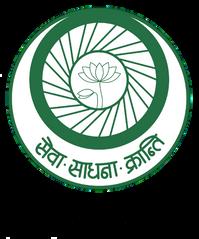Development of an entrepreneurship model pertaining to Heritage Sites
Submitted By SUSHILA MURMU

SBI YOUTH FOR INDIA FELLOW 2020-2021 NOVEMBER COHORT
SUBMITTED ON: 29TH OCTOBER


Submitted By SUSHILA MURMU

SBI YOUTH FOR INDIA FELLOW 2020-2021 NOVEMBER COHORT
SUBMITTED ON: 29TH OCTOBER

First of all, I am grateful to the SBI Youth for India Fellowship Program of SBI Foundation for providing a platform for me to be a part of this journey of unlearning and learning at the same time from our rural communities on grassroot levels I also thank all the recruitment panel for giving me an opportunity to become a part of this fellowship
I am really fortunate that I had the kind association as well as supervision of Seva Mandir, whose encouragement and support from the preliminary to the concluding level enabled me to develop an understanding of this sector
I would love to thank our SBI Youth for India team for being there from the commencement of the fellowship till the completion of the project with their maximum capacity in spite of having difficulties with the Pandemic situation
I convey my sincere gratitude to my Domain Mentor Ms Rimjhim Pandey and Local Mentor Mr Abhijeet Kumar and Mrs Jyotsna Sharma whose guidance made me understand the community and how to work with them in spite of challenges. Without their kind direction and guidance, this fellowship wouldn’t have been possible.

Distinguished thanks to Delwara Block office Staff, who became my family away from home for their care and support whenever needed I would like to thank everyone who has provided a huge amount of their time and effort I am lucky to be able to work with them and In spite of being limited to their deadlines and extremely busy in their own roles, took some time out helping me with planning and decision making and most of all facilitating me and making my life easier
Debt of gratitude is also owed to my fellow mates for their presence and support in my life The one thing I would love to express here is that I found my home in people here who were always there even if they were not having a good day
Lastly, I offer my regards and blessings to all of those who have supported me in any respect during this whole process including my parents, friends who have always supported and brought me up to receive such opportunities in life This fellowship stands as a testament to your unconditional love and encouragement
THANK YOU.
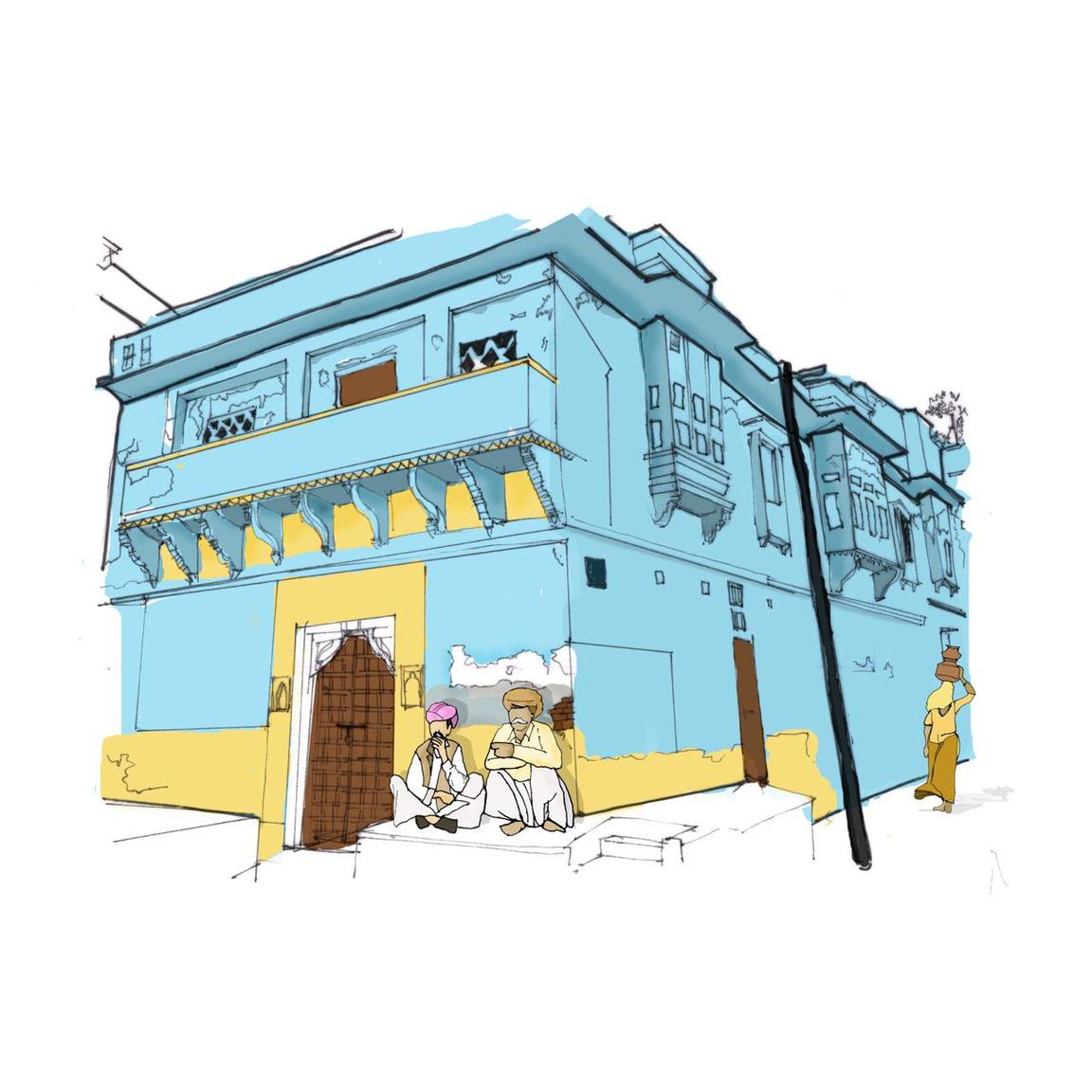
Cultural heritage is widely used in the promotion of small towns, and a range of media are often available to instantly represent it However, the overall images and stories often remain biased towards tangible, monumental, and old heritage, with little effort made to address issues such as a town or region’s difficult past and its contemporary problems, or to make visible and explain links to wider spatial referents
To conserve the local heritage of Delwara, ancient structures, document the history and develop folklore heritage and providing means of livelihood by working in these areas

To ensure that the future citizen have access to quality education, and to equip the Youth with livelihood and leadership skills that will enable them to become responsible citizens at the critical threshold of their lives
To provide the citizens with livelihoods opportunities to help them improve their economic condition and hence improvement in their quality of life Initiating income generation interventions in the sector of Heritage which is being carried out by Nagrik Vikas Manch in collaboration with Seva Mandir
Title Page


This pilot focused on the challenges and perspectives of small towns Towns are often in the vicinity of a city, usually in the countryside and so have both urban and rural influences.n particular, this pilot explored the uses of cultural heritage in small towns. More specifically, it mapped how cultural heritage has been defined, represented and used by small townsThe major objective was to recognise potentials and problems that foster or block pathways for uses of heritage in resilience-enhancing ways, and to outline avenues for better practice. A range of documents were analysed, such as towns’ self-promotional materials, and local heritage-related institutions’ initiatives, measures and events were mapped, which provided the pilot with an understanding of the common patterns and diversity in how cultural heritage is used as an asset in small towns, by whom and for what purposes. Selecting attractive area features and defining clear promotion plans are part of marketing a small town
Delwara heritage is important because the sites not only talk about physical history or social inheritance but are the sites of social change. The heritage walks have been organised to promote conservation and awareness about the rich history and legacy of Delwara.Each walk offers a window into small-town India and explores the past decade of transformative development and social changes brought about by the people of Delwara and Seva Mandir. Each walk is distinguished by the guide’s own stories, opinions and relationships.
Outdoor enthusiasts look for different features in visiting small towns, but a multidimensional marketing approach focusing on a variety of outdoor and natural elements casts a wide net to attract travelers and potential new residents Inclusive marketing campaigns integrating print and online materials showing the outdoor attractions, in-town and nearby dining options, overnight lodging alternatives and directions from a well-known geographic center help bring visitors to the small town. Marketing materials showing year-round outdoor activities attract new residents.

The idea of working with youth arose out of the sense that Youth were not getting a space to engage with the development process, they are the citizens and leaders of the future. By working with the Youth it would be possible to tap into their inherent energy for change and at the same time, to nurture values that are suited to craeting a responsible citizen for the future. Wide range of activities are being carried out with Youth from Delwara, engaging them in activities and discussion related to wide range of development issue but considering my project brief my idea of indulging them with the tangible and intangible heritage of Delwara to be able to provide livelihood opputunities through existing interventions of Seva Mandir in terms of Heritage Conservation in which they have established Delwara Heriatage and Community Walk started in 2012 as well as a torch bearer of the legacy of Delwara and to promote it furthur.
This is a guided tour of a village with historic temples, stepwells and a royal palace (now a 5star Boutique Hotel under RAAS Boutique Hotels). The tour guides grew up in the village and still live there and will introduce travellers to its villagers and artisans who themselves can provide guided instruction on their arts, for example pottery, jewellery and stitching. The guides will also take travellers into old temples, access to which is normally restricted to worshipers The tour provides a unique opportunity to see a real part of India which is not otherwise seen by tourists and to learn about its way of life. The tour is in fact an initiative of the NGO Seva Mandir in order to help preserve and highlight the unique heritage of Delwara and to provide job opportunities to its young guides who run the tour
In this time of general globalization and unification, the importance of cultural tourism is growing faster than fancy trends. Cultural tourism is not just a current whim It has been developing for centuries - from the departures of the first pilgrims until this modern time where the discovering of identity and uniqueness has become a common phenomenon Uniqueness and specificity that are far from the hurried everyday life, actually open new possibilities for the exploration and the defining of the meaning of cultural tourism in these last twenty years. In this global accelerated development, the distinctiveness of an offer grows in accordance with the development of the image of a destination, and in accordance with the generation of competitive advantages The cultural and historical heritage is very often included in different promotional materials, but it is in itself not adequately prepared to be a properly managed attraction

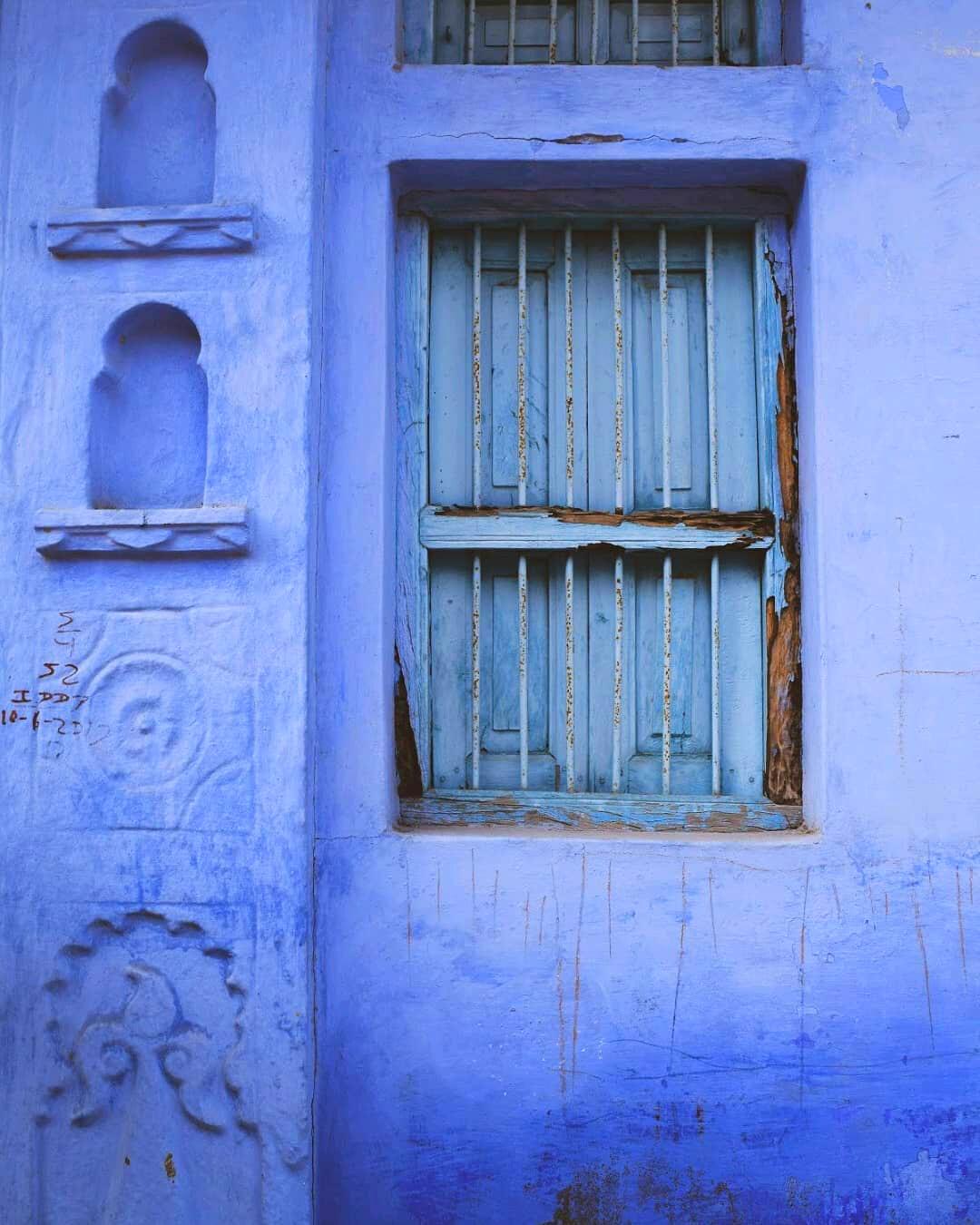
Seva Mandir is a non-profit organisation based in Udaipur, southern Rajasthan, India Conceived in the 1930s, the organisation was founded in 1968 by Dr. Mohan Singh Mehta
Initially, its work focused on adult education, the aim being to equip the rural, predominantly tribal, citizens of Udaipur district, southern Rajasthan, with the skills and capacities that would enable them to become active agents of their own development. The focus was on preparing leaders to work on development issues in partnership with the government bodies such as the panchayats
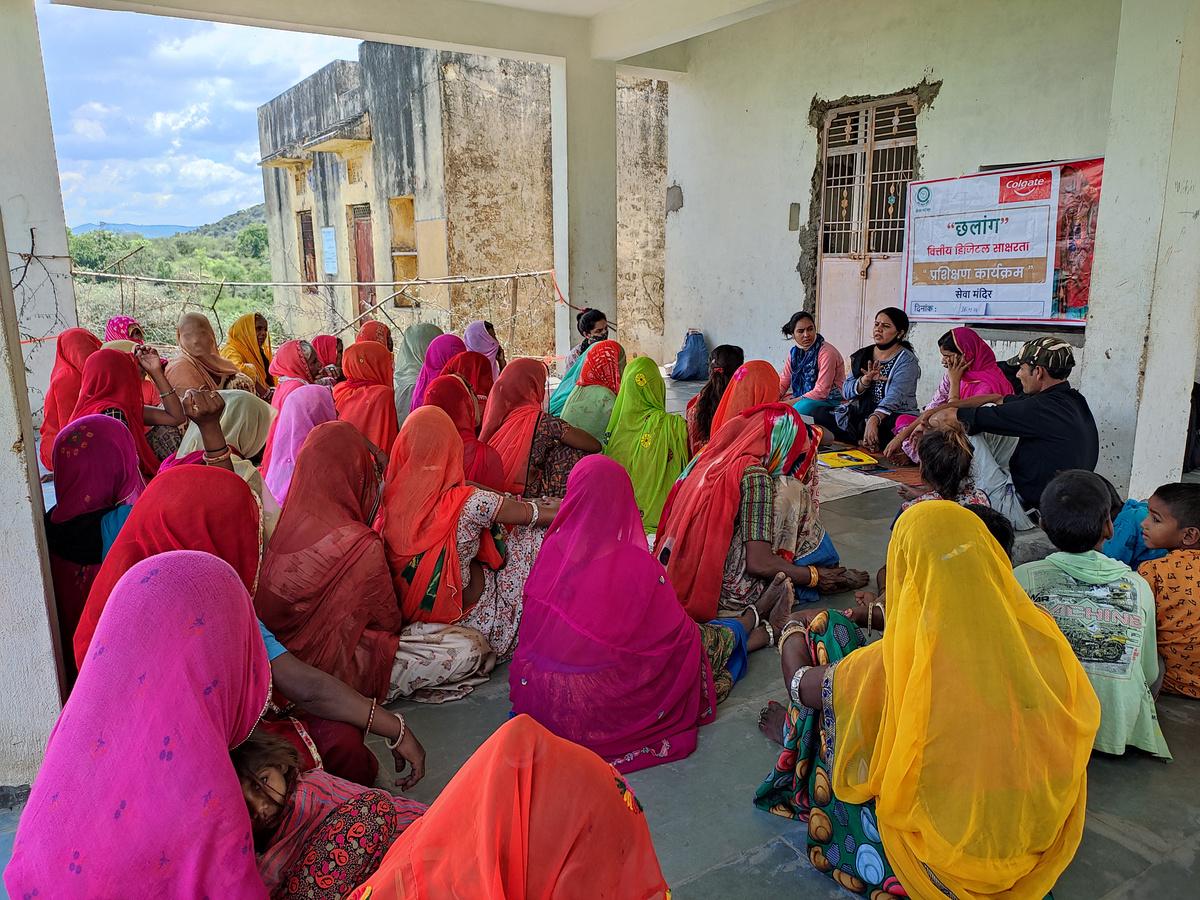
Over the years, it became clear that, while this work was contributing to change on the ground, it was not adequate Seva Mandir responded by diversifying its repertoire of activities to include natural resources, education, health, sanitation and clean drinking water, youth engagement, women and community institutions
All activities are implemented by means of our engagement with the community institutions which form the bedrock of all Seva Mandir's work, and within a framework based on the Gandhian notion of constructive work
In recent years, Seva Mandir has begun extending its approach to development beyond rural areas to include both periurban townships and urban slums Although these areas have distinct social, political and economic realities, the underlying principles that characterise Seva Mandir's work are still of great relevance in bringing about positive social change
Seva Mandir's mission is to make real the idea of the society consisting of free and equal citizens who are able to come together and solve the problems that affect them in their particular contexts The aim is to construct the conditions in which citizens of plural backgrounds and perspectives can come together to benefit and empower the least advantaged in society
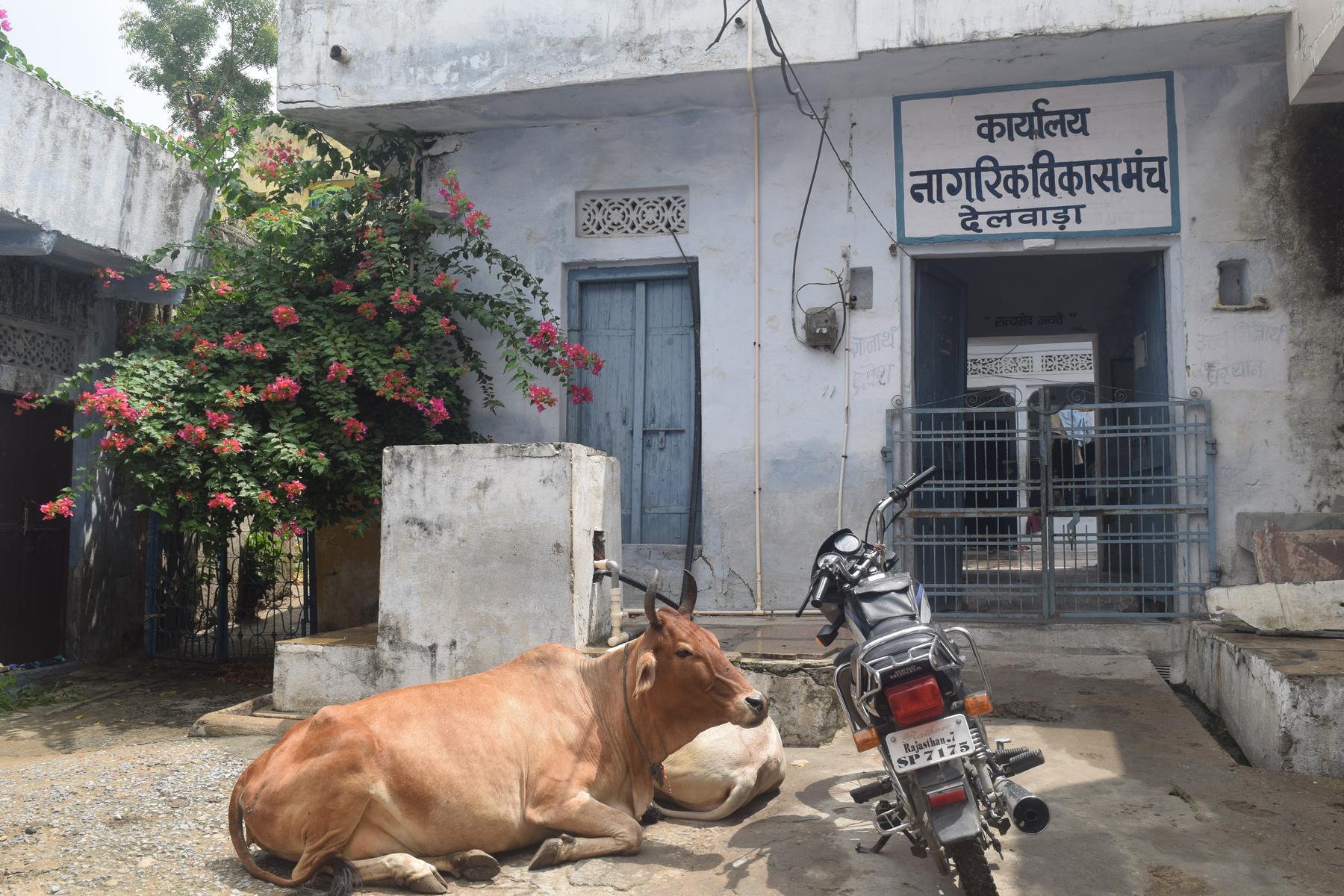
Delwara's association with Seva Mandir has been mainly because of the Women's Patchwork Program The women of this place have been organized into SHG's presently running as a Fair Trade Handicraft Enterprise named SADHNA. The presence of a strong women group paved the working in area of Urban Governance in the village
Seva Mandir has worked to develop new institutional spaces to encourage citizens to participate in governance and the development of Delwara as a whole. It has created a platform where citizens can work together, irrespective of caste, creed, and gender biases - the Citizens’ Development Forum or Nagrik Vikas Manch. Nagrik Vikas Manch grew out of the idea of having a platform through which citizens could take more active responsibility for their development process and through which collective action would become possible. Seva Mandir’s experience in Delwara has contributed to the public understanding of how constructive work in peri-urban areas can lead to self-governance
The lives of Delwara’s citizens have improved significantly as a result of the governance initiative and there has been greater social cooperation as citizens work together on development issues There is a greater commitment amongst the citizens themselves to uphold norms of fairness, justice and responsibility, and a strong belief among citizens that they are now participants in the development and management of their town, and that they have a role in defining a vision for their town
Seva Mandir is the organization responsible for field level coordination and implementation of the Delwara Development Project Seva Mandir's work can be divided into two main categories
Planning Implementation, monitoring and evaluation work based out of the field level office
Consultative and advisory work based out of the head office, Udaipur
Delwara suffered from severe water scarcity in the past. The availability of water depends primarily on the monsoon, with a couple of traditional water-harvesting structures helping to retain rainwater Over the years, there were few attempts to maintain these structures, and the community used them as garbage dumps.
Seva Mandir and the Citizens’ Forum made it a priority to rejuvenate the traditional water structures like Palera pond or Trimukhi step-well, engaging the community at large to help in the process The deepening of Palera improved rainwater retention throughout the year and all the other traditional water structures in Delwara were connected to it, thus helping to refill all the water structures
In order to improve access to clean drinking water for Delwara’s tribal community, Seva Mandir constructed a water tank and provided water pipes to take water to around 100 tribal households which live in the very uneven, hilly part of the town.
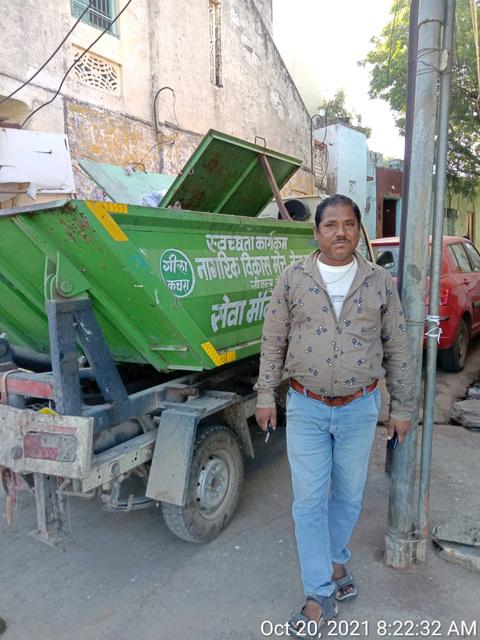

Seva Mandir has helped the households construct 233 toilets in Delwara which contributed to declaring the town open defecation free (ODF+) this year The community at Delwara appreciated the work done by Seva Mandir and NVM in constructing toilets and helping the area progress towards the ODF+
he Citizens’ Development Forum gave the cleaning personnel a platform to share their concerns with the community at large, which would have been unthinkable not so long ago

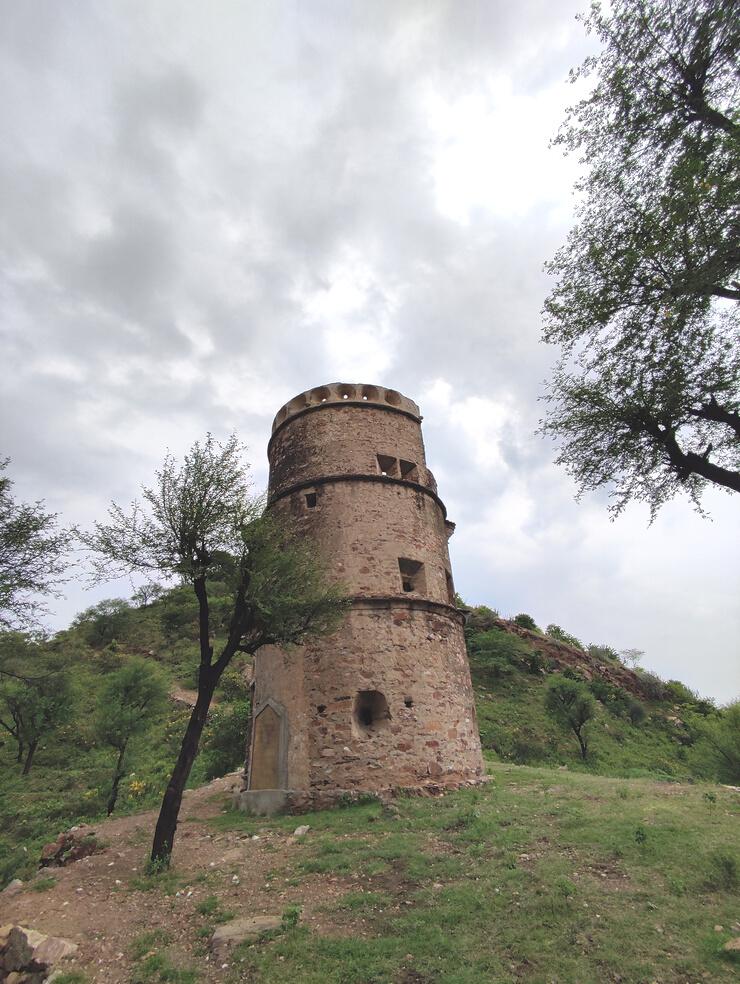
Located in the Aravalli hills of Rajasthan and home to the fort-hotel RAAS Devigarh, the picturesque farming village of Delwara commands one of the three main passes into the valley of Udaipur. Built in the 18th century and once home to the rulers of Delwara, RAAS Devigarh perfectly captures the magic of rural Rajasthan and it is one of Ampersand’s favourites hotels This magnificent forthotel is perched on a hillside overlooking the colourful village of Delwara, a gentle stroll away
Delwara is easy to explore on foot and the village itself boasts four 14th century Jain temples, which formed the inspiration for the famous temples of Dilwara near Mount Abu Known as the “town on the gods”, Delwara once boasted over 1,000 temples, of which 400 were Jain Mandir Temples Though many have turned to ruins, today every street in Delwara has at least one temple. Aside from temples, other highlights in Delwara include the Indra Kund, a lovely Step Well with beautiful carvings, and Audhi, which is an old hunting tower on Kantya Hill with panoramic views Delwara’s community is varied, made up of Jhalas (Rajputs), Patels, Gametis (Bhil tribe), Muslims and Jains
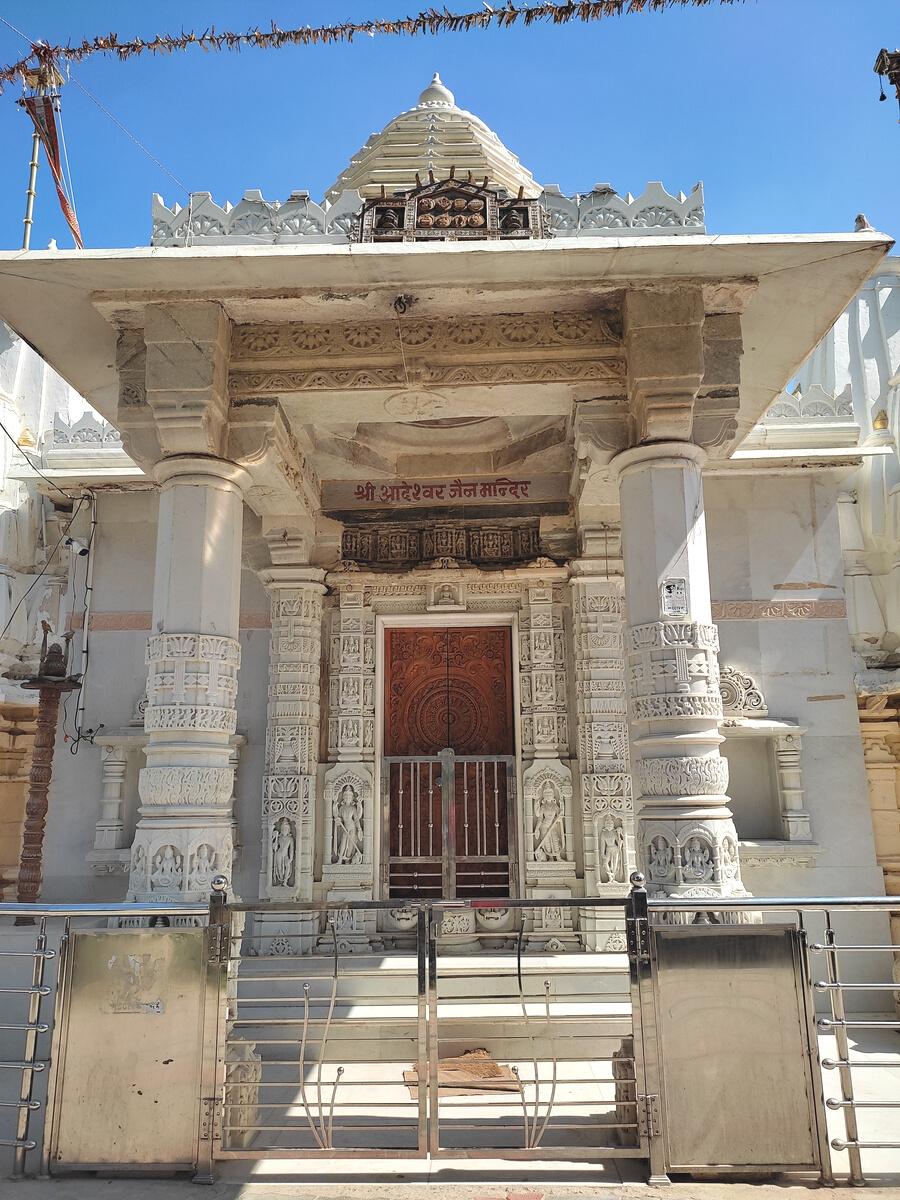
According to Shri Harak Lal Pameecha, a retired lecturer and resident of the town, Delwara was a part of a very large settlement called Devikul Paton Nagri that stretched from Kailashpuri to Gandak Sagar. it was a large ans prosperous settlement with hundreds of Hindu and Jain Temples The presence of the ancient temples of Kasheshwar Mahadev, which appears to be date back to at least 10th Century and the beautiful 9th Century temple of Eklingji at Kailashpuri, lends sufficient credence to the antiquity of the settlement as a whole.
Delwara is a peri-urban town located on NH 8, about 30kms away from Udaipur Due to its location on the national highway it is well connected to the town and therefore the people have easy access to all the amenities of a town.

Delwara has a strong presence of Community borders. People belonging to diverse religious and caste reside in thier respective mohallas Although the relation between people are very harmonious, participation in each others festivities can be seen often
Delwara is an example of many such periurban settlements in India caught in "Sandwich Situation" bearing the brunt of both rural and urban problems From last decades, Seva Mandir have put immense amount of effort to make this town a model for peri-urban settlements and have learned from the interventions about how to manage integrated development in peri-urban setup.
The development of cultural tourism in small historical towns did not have a significant importance until these last few years. Small towns were independent units for themselves, left to the political decisions of the municipalities or cities, which generally did not recognize the true value of small urban environments for the development of tourism Most of the small towns were left to influences of past times, with unsettled proprietary relations and poorly maintained buildings, with unacceptable upgrading and building within the boundaries of historical entities, and with the unacceptable standards of modern life All of this prevented the normal development of small towns. The tourists’ growing interest to learn about the cultural and historical heritage is a result of education and an improved standard of living The cultural and historical heritage of small towns, which is poorly represented and promoted, remains an insufficiently used resource in the tourist offer The development of cultural tourism must not in any way disturb the balance of the social and economic living conditions of the small towns and it has to preserve their cultural identity In the process of globalization, it is necessary to evaluate all resources of the cultural heritage and to create new possibilities for the creation of a tourist product As a result of the abundance of cultural and historical heritage (primarily the way of life and the creativity of some past times), it is possible to develop cultural tourism as a form of economic and social interest
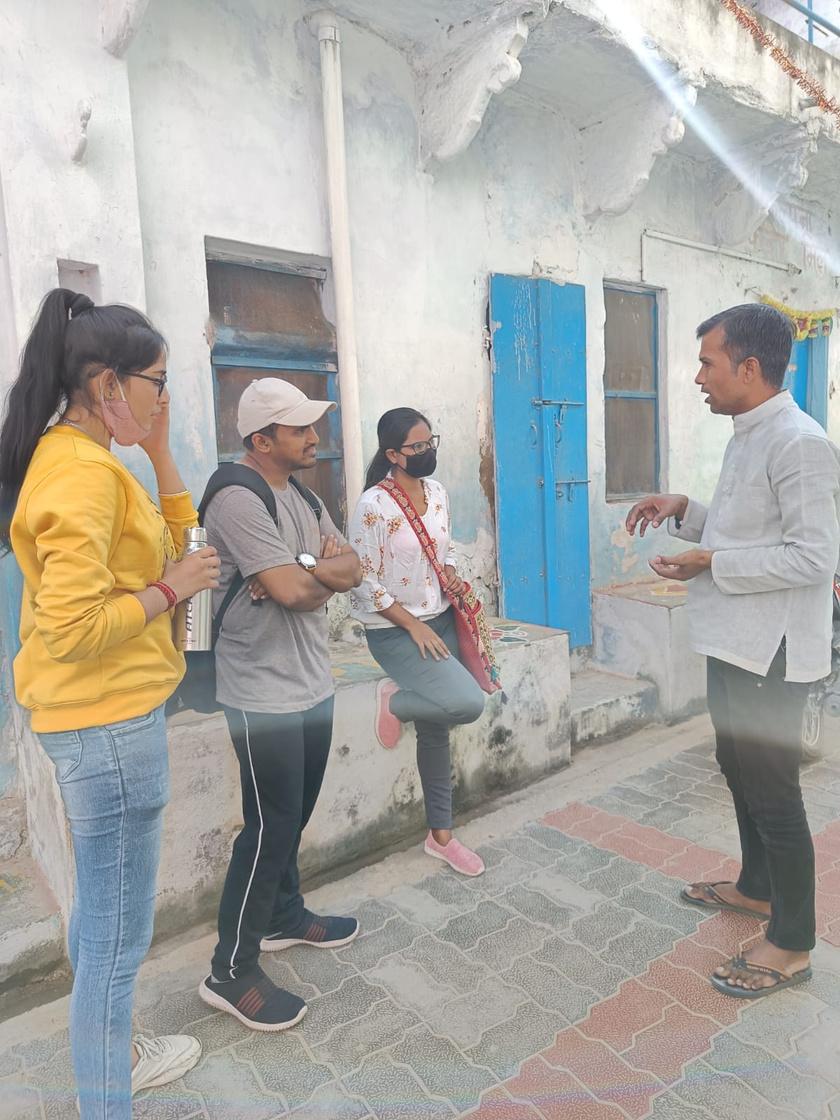
The Delwara Walk started as a project to generate local jobs and publicise the development work accomplished together by Seva Mandir and Delwara’s people over the past 15 years It has, however, had a wider impact.
Together with a Seva Mandir volunteer, young people from all three major religious communities researched the town’s history and heritage sites and were trained to lead tours taking in its little known heritage sites and visiting artisans practising their traditional crafts (potters, artists, goldsmiths) But, unlike other heritage walks, this one goes beyond physical heritage to consider questions about women’s rights, access to water and toilets, caste discrimination, livelihoods and other aspects of Seva Mandir’s work Walks are also being organised with Delwara’s schoolchildren so that they too can begin to learn about and take ownership of the development of Delwara
A Seva Mandir volunteer selected 20 local youths from the Youth Resource Centre and trained them in spoken English and local history so that they could conduct heritage walks around the town After intense screening, six young people were finally selected as guides. On 30 August 2013 the Delwara Heritage and Community Walk was launched by the Minister of Culture Visitors are charged Rs 300 for the walk, which covers 16 points in the village. 90% of the money collected through these walks goes to the guides, while 10% is deposited in the youth fund
Delwara Heritage and Community walk is an initiative by Seva Mandir and local Community to showcase the heritage to the whole world but considering recent incidents this walk was also affected by the Pandemic. Their livelihood has severely affected the pandemic because there was no flow of tourists The idea is to rejuvenate the Walk system and make its presence in Rajasthan and Pan India as well as on Virtual Platforms of Tourism
The objective is to improve the financial condition of the population after a pandemic situation whereas most of the population lost their jobs and looking out for livelihood opportunities. Developing Delwara into a tourist destination to increase the employment possibilities and improve the living conditions by improving the infrastructure in and around the heritage of the town Inculcating Youth population into the pre-existing heritage walk and train them to be a local guide for the walks in Delwara also incorporating already existing women samuhs with the initiative to improve their financial conditions and provide them with more opportunities in the market around the heritage walk system
The idea here is social empowerment of youth and women and capacity building, putting it in place of the physical development plan to include a process of social change Mainstreaming the work of youth and women in addition to a wide range of development activities on these sections of the society, including the YRC, a range of livelihood-oriented and training opportunities, and cultural events on a monthly or annual basis.
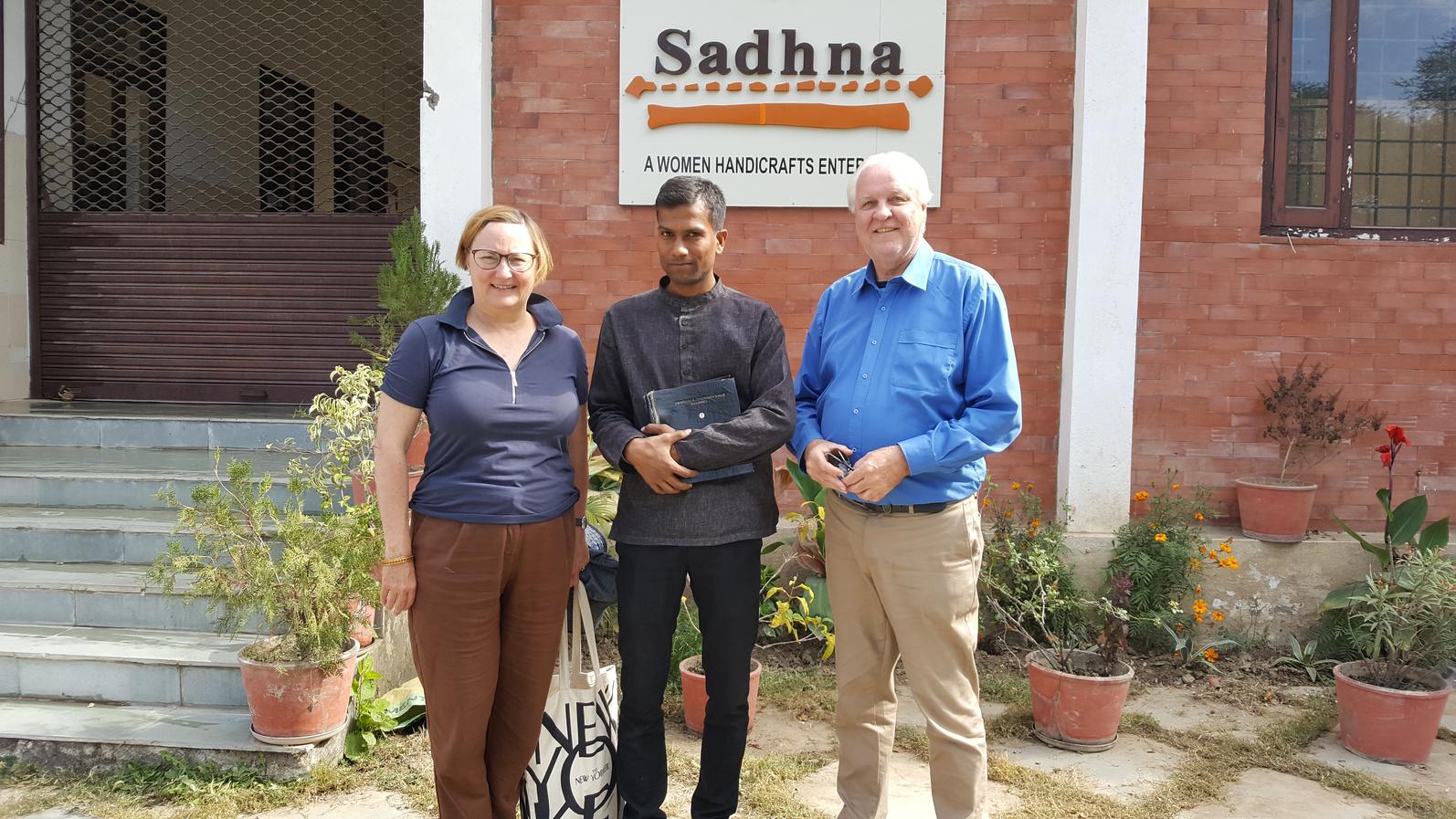
Due to the complexity of applying a participatory approach of a context like Delwara, with a wide range of diversity and fragmented population and highly politically charged profile can lead to the reduction in community commitment during the course of the implementation Because the timeline between the work to be undertaken and the actual implementation can be directly affected by it Today’s concern is the absence of a holistic and well thought out sustainable development plan for this kind of existing town.
There are few factors that make Delwara an upcoming tourist destination around and can attract major tourist from in and around Rajashtan:
1 The location is next to a National Highway and in proximity to a major tourist location of Udaipur Because of that proximity, Delwara can be recreated as a new addition in Rajasthan Tourism and that can lead to the economical and physical transformation of the town.
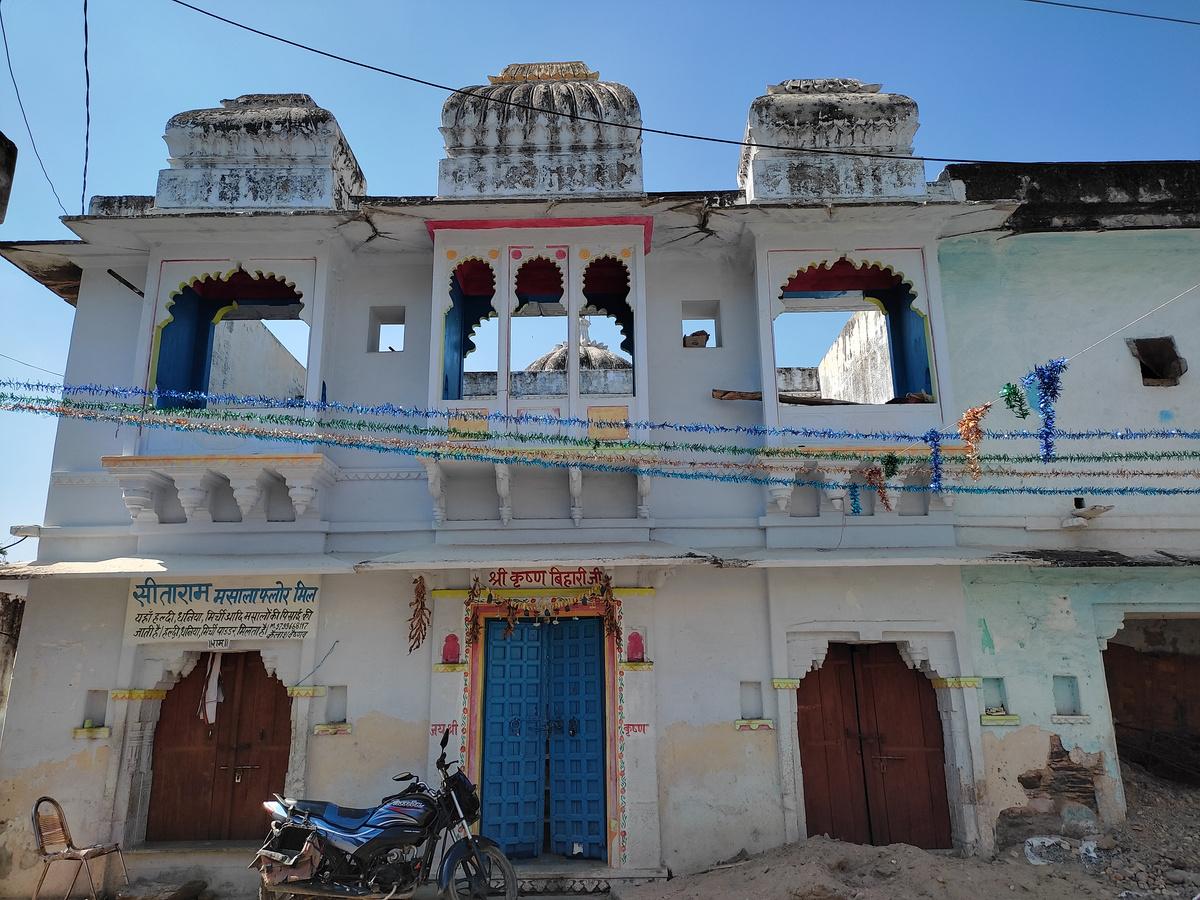
2 The Delwara fort is now under RAAS Boutique Hotels, which is now called Devigarh Hotel also opens up a possibility of a major thrust of tourists from abroad which will provide a bigger market for the locals in terms of the hospitality industry and handicraft business that can be incorporated with SADHNA (a fair trade initiative).
3 Religious Tourism: The presence of local heritage, ancient structures, Jain temples, kunds, water bodies, folklore can attract a major religious population
Evaluation of the existing tourism and livelihood setup in Delwara
Review of Already existing Route Map of the Heritage Walk
Planning and Execution of Community Centric Activities based on Heritage/Youth/Women and Sports or Cultural events
Assimilation of Data on Youth residing in Delwara who can be a part of the Existing system of the walk and can also participate and be a part of it
Advertising of the Walk on Virtual Platforms as well as physical grounds around Udaipur and Nathdwara
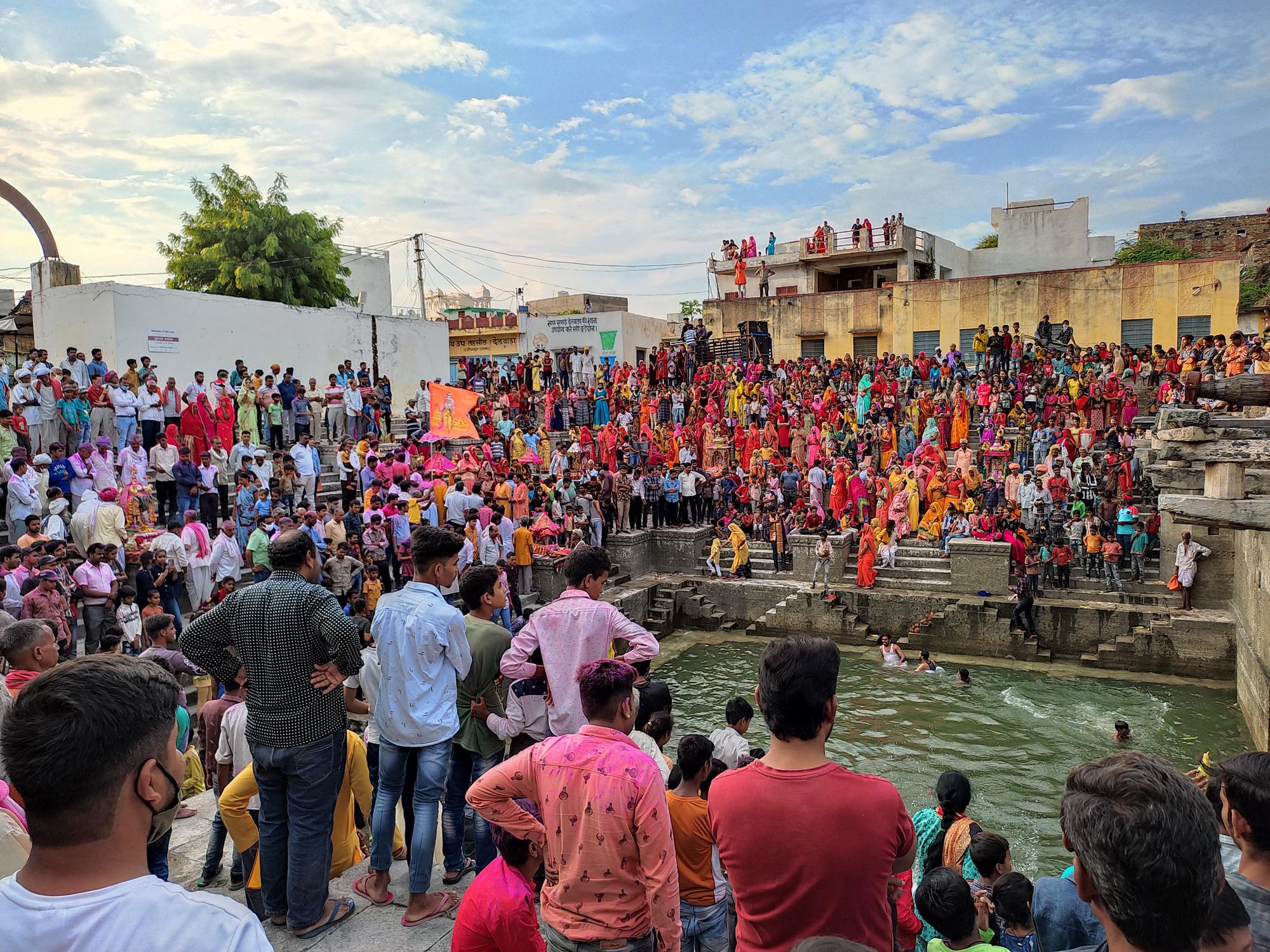
Setting up well defined process for conducting tours: Devised a model itinerary and the handing over of the itinerary to the tourists in printed format (Brochure)
Creating Creative spaces for the community to assess the idea of Heritage and to look forward to it The focus of this to create Wall art, Installations to make the specific spots more relevant in terms of Heritage walk as well as can be used for various other festivities
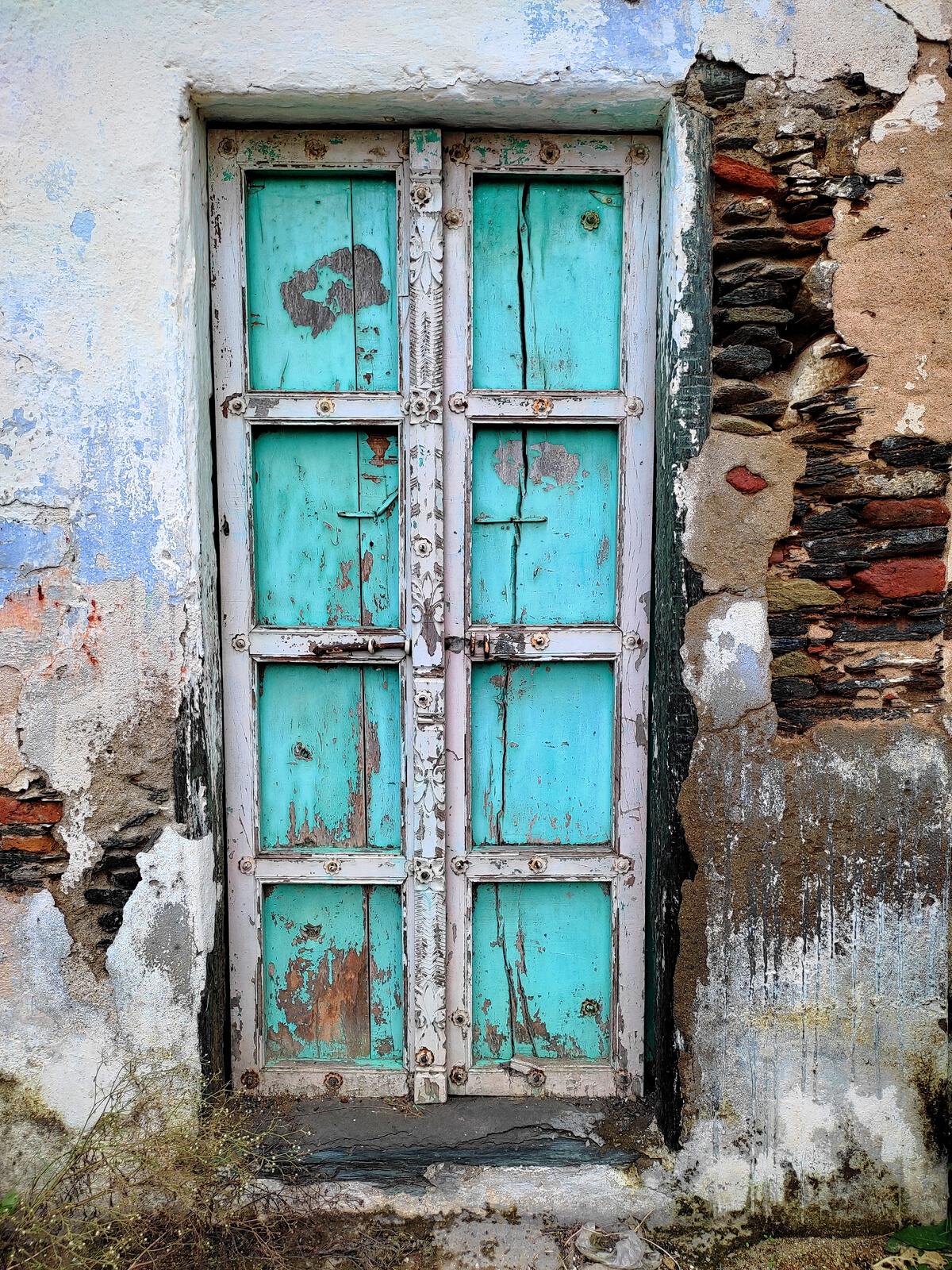
Seva Mandir is closely working in Delwara for more than a decade and have been associated with developing many facets of Delwara including Peri-Urban Governance, Water and Sanitation, Solid Waste Management, Heritage and Cultural Preservation but all of these are infrastructural development to provide basic amenities to the local population but other then this we should also be focusing on the ways to improve the quality of life of the people living there considering ways of livelihood and income generation. In light of the present situation, Delwara is suffering to employ its local population in so many different levels including youth and older generation they are very much dependant on nearby cities like Mumbai and Surat for their livelihood and therefore migration is higher in this town
Udaipur being the nearby city also provides means of income for people of Delwara
Putting Heritage on the front can provide and open doors for different kinds of livelihood opportunities in which Delwara Heritage and Community walk in already there to provide a livelihood for youth Other than that SADHNA the Handicraft can provide opportunities for a clothbased or traditional craft-based market in which the local community can earn money. Inculcating Youth and Women with the existing structures will give them means of income and there will be minimal migration from the place Lack of infrastructure and livelihood opportunities leads to the major flux of youth and earning members who move out of the town for better opportunities. Other than this other handicraft enterprise like pottery, food experience in which authentic Rajasthani Cuisine and local art forms can be showcased for the walks and can be celebrated in as a festival on a yearly basis which will also attract more tourist into the village
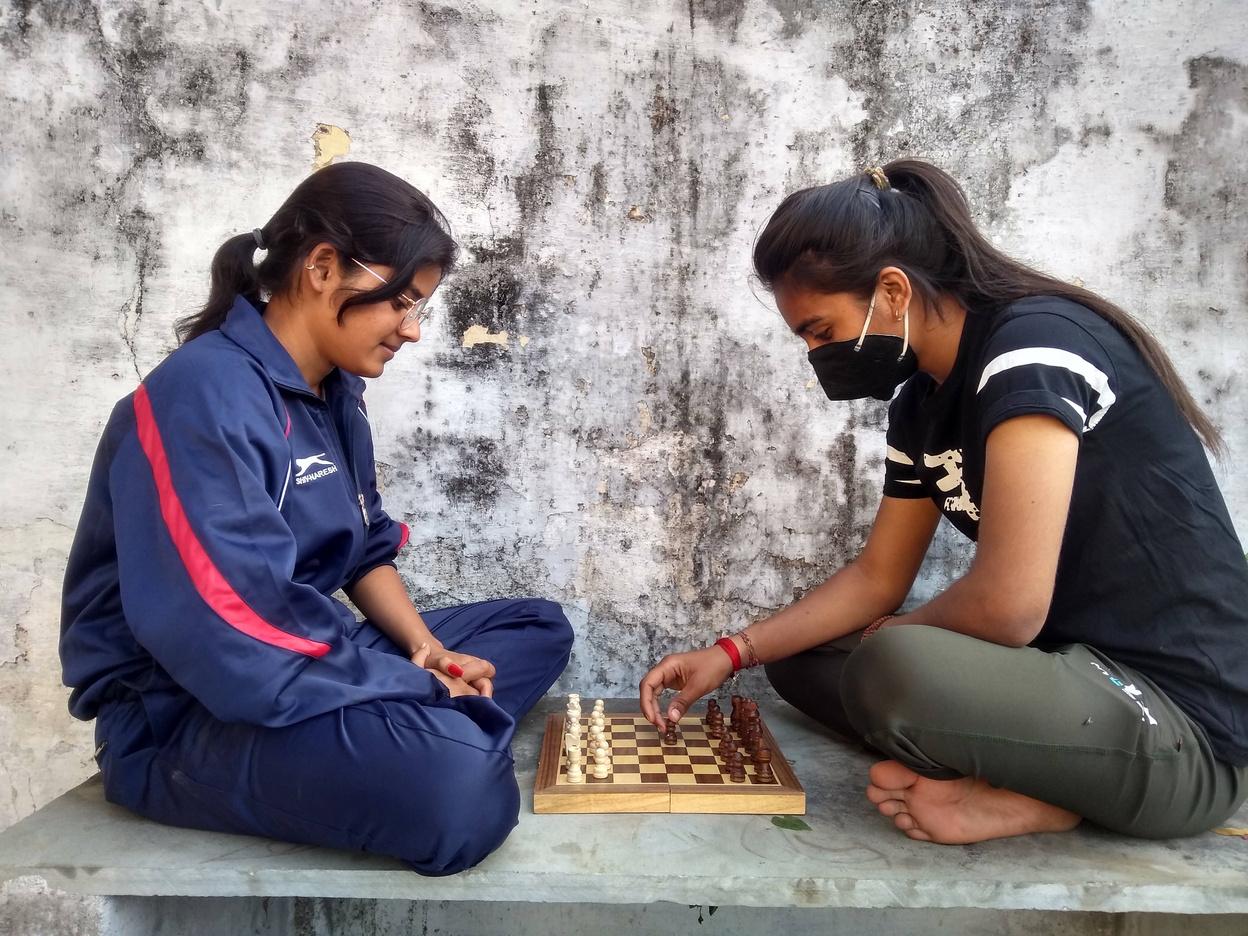

The idea behind this whole exercise is to create ownership amongst the community regarding the Heritage and also for the maintenance/cleaning/preservation of tangible and intangible heritage
Addition of more Youth with the existing structure of Heritage Walk and other livelihood opportunities in and around Delwara Capacity Building of the Youth inculcating Soft skill Development Classes, Confidence Building exercises, Spoken English Classes so that they can manage tourists coming from Abroad and Non-Hindi speaking Areas.


The heritage walk was on standstill after the Covid Pandemic and needed changes and marketing and flow of tourists in the relocation For that Independent Website of the walk was the need because it was totally dependent on other travel websites Other than that virtual marketing and on-ground marketing were also needed Linkage of the Walk with nearby Hotels and agents of Udaipur and Nathdwara

Shramdaan Activities Heritage Properties
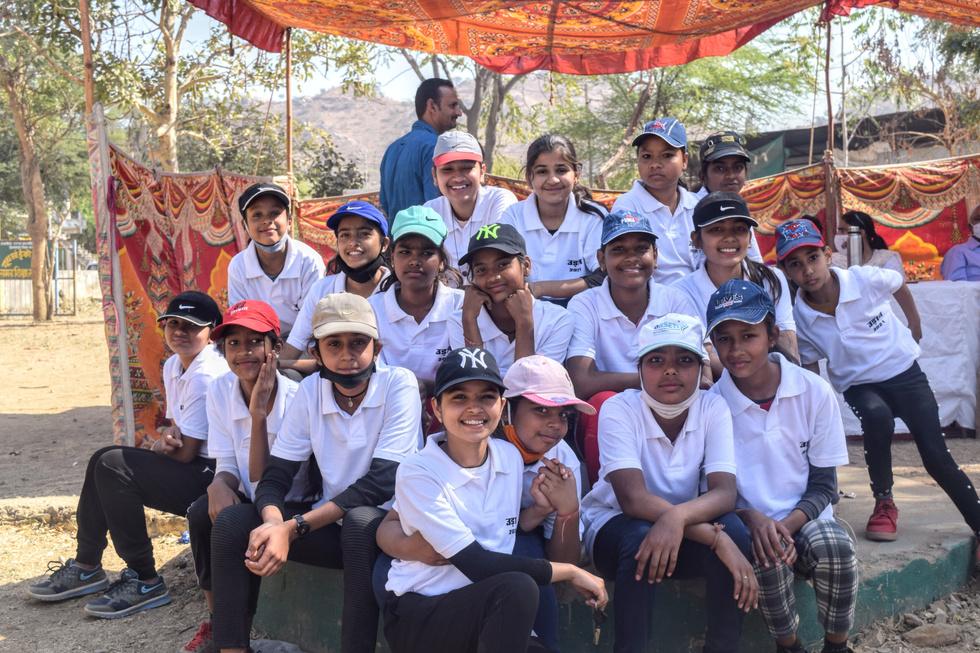
Mohalla Meetings
Tree Plantation Drive in Delwara
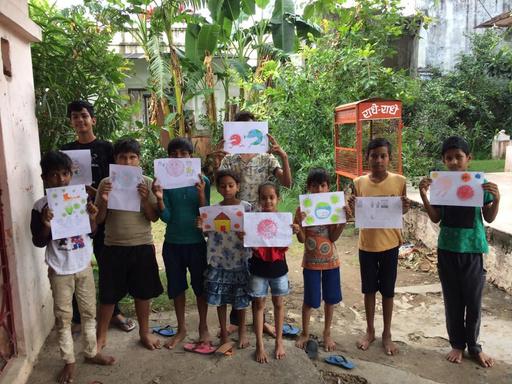
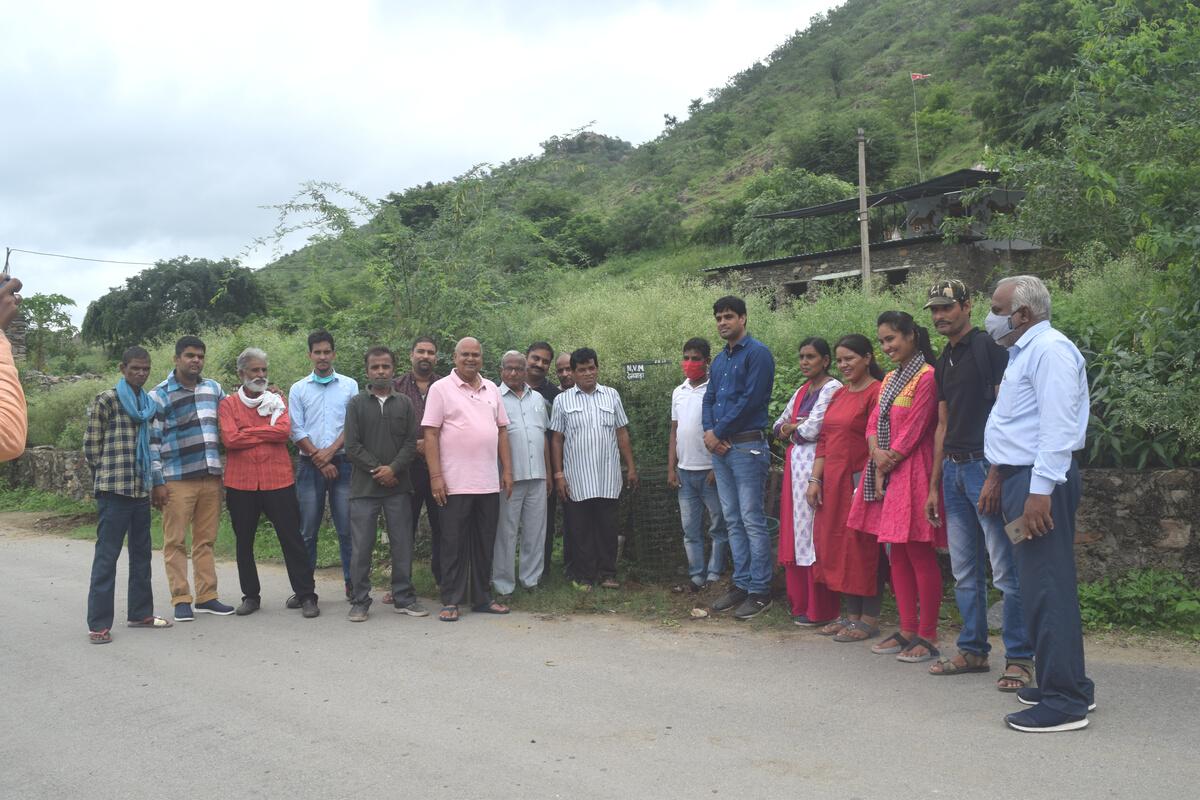

Covid Awareness Workshops in mohalls
Participated and organized
Financial Digital Literacy Workshops
Annual Sports and Cultural Festival
UDAAN 2021
encourages young people from the community to participate in locally played sports and cultural activities
There is a huge demand for English learning amongst the youth of Delwara It boasts confidence and open career prospects for them

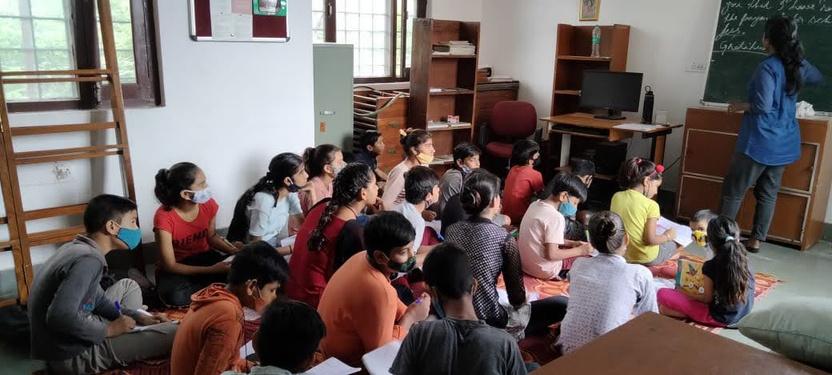
To date the project has contained a substantial mix of 'successess' and ''failures' Viewed from some angles, one year is a short time to bring about profound change within any social system.
Nagrik Vikas Manch in collaboration with Seva Mandir will have a mutually supportive institutional relationship with the panchayat and under that umbrella developmental Activities Youth will be taking responsibility to take part in development activities
Youth Vollyball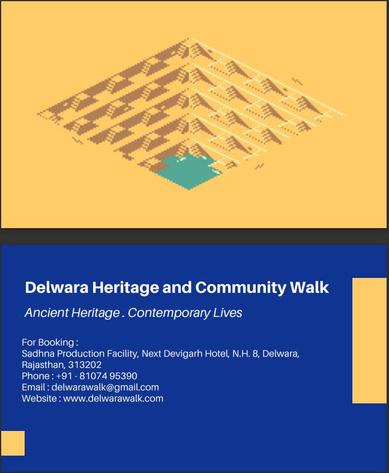



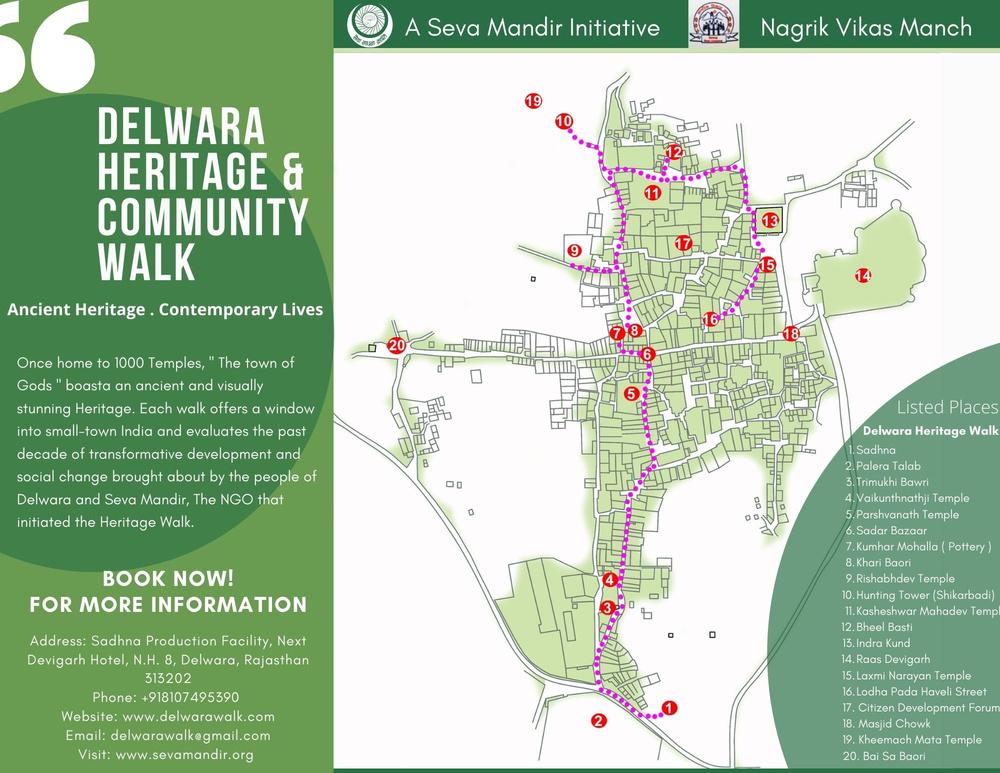
 Poster
Poster

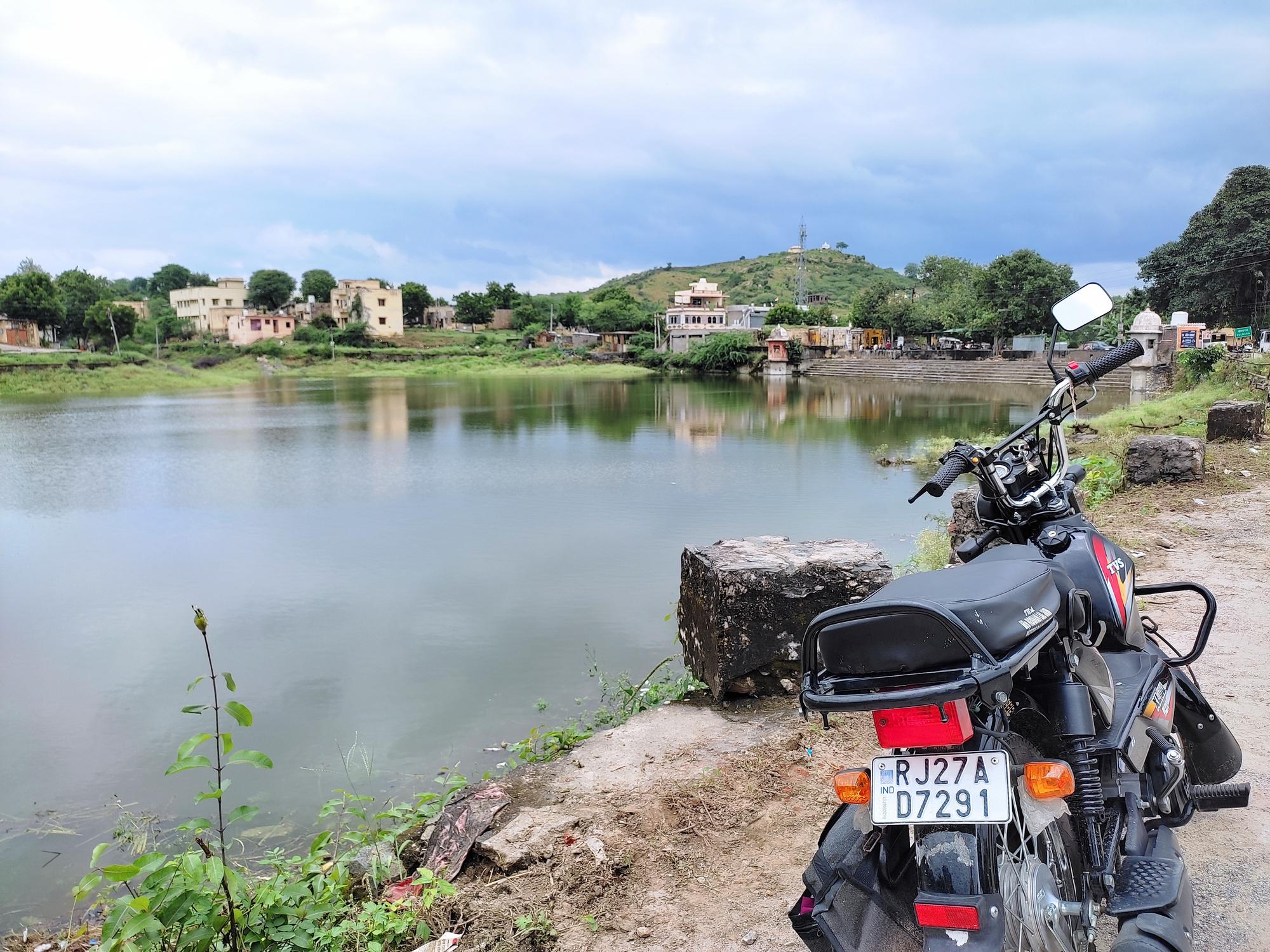
Without strong leadership at the mohalla and Nagrik Vikas Manch level and a more carefully thought out approach to community leadership overall, it is very difficult to ensure the sustainability of the Nagrik Vikas Manch. As a result, without more widespread active participation across the community, the work of the community mobilizers cannot be sustained simply through meetings with community members once a month.
There have been problems in translating the proposal into work because of the complex administrative structure and the system on ground and this makes it difficult to maintain interest at the Mohalla level In the addition to this, inactivity of the program committees has meant that decentralization of the workload has not been possible
Improvement in the quality of mohalla leadership to ensure quality and enthusiasm through various means ensuring community participation in the process of development of the town
Small, localized activities which show results are important for building up trust and ownership within the community However, such activities, by their nature, are location/community specific and may not be adequate to bring different sections of the community together in the process
Considering Delwara's diversity activities which reach out to all the communities together should be introduced on regular basis to ensure communities participation in the development process
Development is ultimately a process and cannot perceived as a project What can be measured is extremelyimportant because the frameworks of success and failure can only capture so much and don't always capture the social relationships that are changing. These includes people's mindsets, beliefs, attitudes and ultimately the changing power dynamics in which people's lives are embedded Even within communities there's a lot of fragility, they are constantly dymanic, they re constantly splintering, sometimes there are self interested reasons, sometimes pretty feuds, but micro communities are changing and are not stable and this is something the development work has to constantly keep in mind
Patience is the key. There are times when you see things aren’t moving as planned But you have to stay patient, wait, improvise, sometimes unlearn and continue your work Things fall into place and also fall apart for a reason. All you have to do is be patient and keep doing the good work
Constant motivation and encouragement plays a key role in the learning process And when this is a two way process, it also strengthens the learning gradually It is essential to keep motivating your team and be motivated by the little efforts they put in You can’t expect them to turn into experts overnight The little efforts that they put in are worth the appreciation, given their background and way of life.
It’s important to cultivate a strong Social presence in the community as one cannot do everything in isolation, especially when the idea is to bringing about a change in the lives of people This also helped me in understanding and appreciating local culture and that human behaviour is not as complex as it might seem to be

In the present world where technology is the means to reach every house and every individual in the world living in any corner of the world can be reachable using social media To grow the network of Delwara and to make it presence on the map social media should be used extensively. Pages should be made on Instagram and Linkedin to grow the network in the market Functioning of Facebook Page should be regular and to be maintained on daily basis
It is important to train new guides I have taken Spoken English Classess Making of the manual for English classes so that new guides can be selected on the basis of that Give the manual test to the new trainees to assess the level of their English understanding If there are several potential guides, this test should be used to compare their ability and potential Delwara Heritage and community should be marketed around nearby cities like Udaipur and Nathdwara so that it will get the major flow of tourist from these places who comes to visit and Udaipur and temples of Nathdwara can take a 30km drive and explore Delwara.
LINKAGE OF THE DELWARA TOURISM WITH PAN INDIA AND RAJASTHAN TOURISM
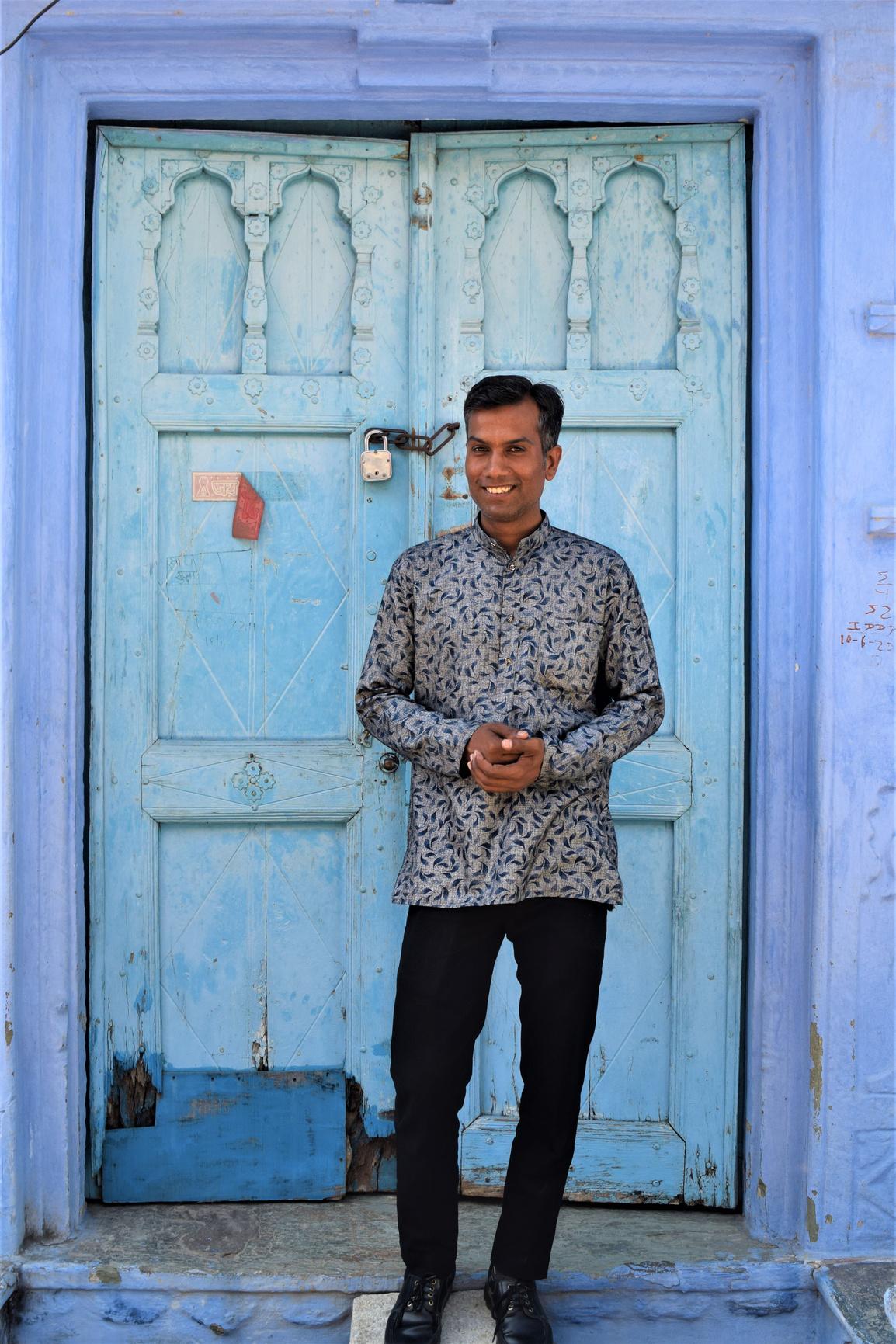
Delwara Development Project, Comprehensive Annual Report, April 2006 to March 2007
Seva Mandir
Delwara Field Guide, People's Management School ( 2007 ), By Marie Grasmuck and David Granjon
Delwara Baseline Study, December ( 2004 ), Seva Mandir
Constructive Work as Self Governance, Improving Lives in Delwara, A transcription Report of the Proceedings ( March 26, 2015 ) By India International Centre, New Delhi, Seva Mandir, National Foundation for India
www.sevamandir.org ( Works on Delwara )
From Stepwells to Self-Help: Delwara, the Other Face of Rajasthan | Nat Geo Traveller India
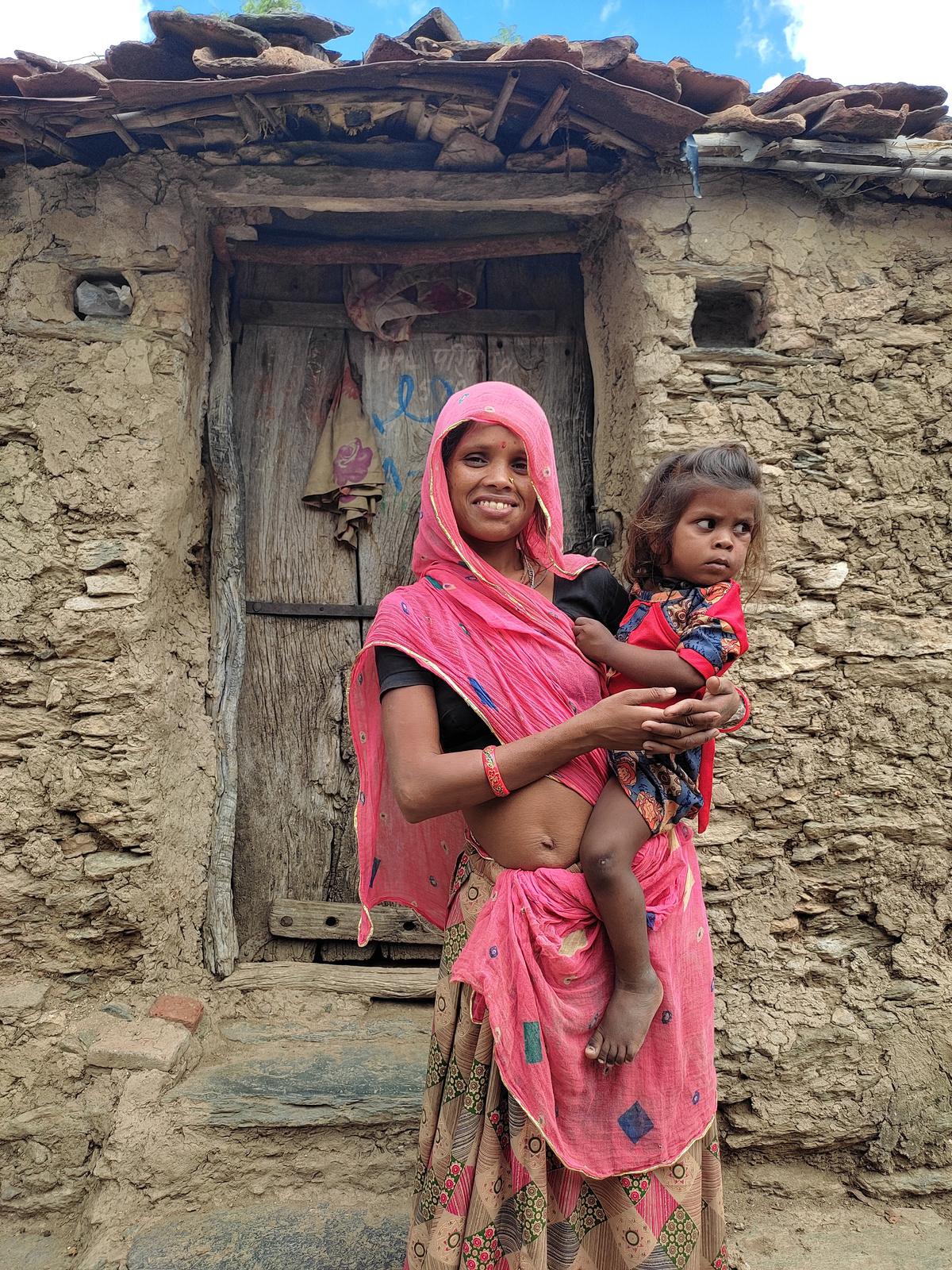
NAME: HIMMAT DAS
VAISHNAV
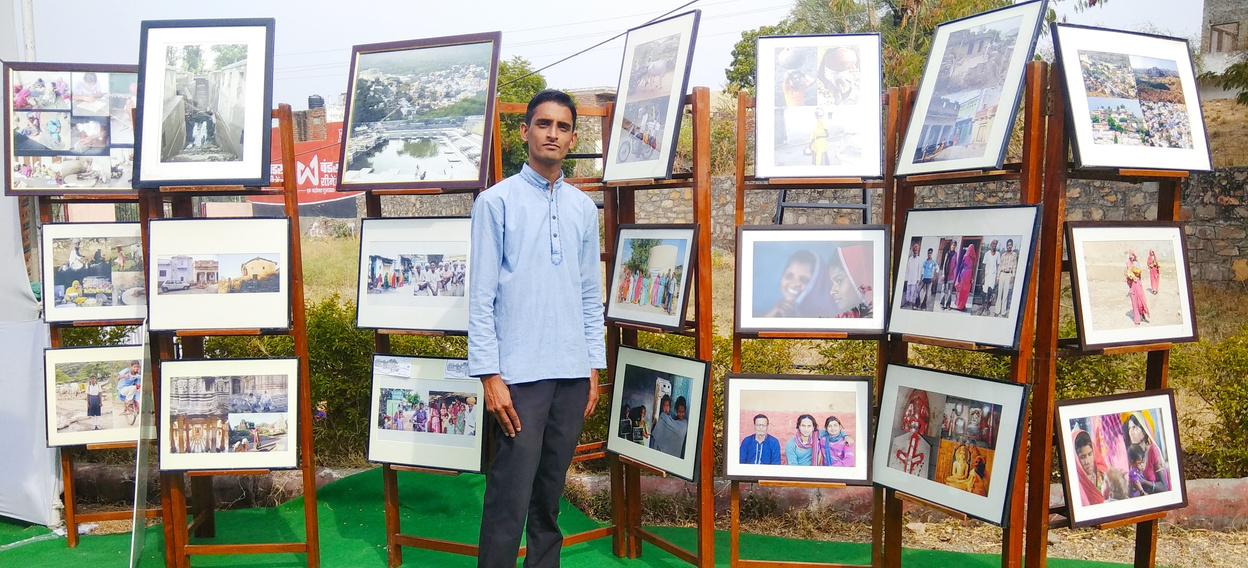
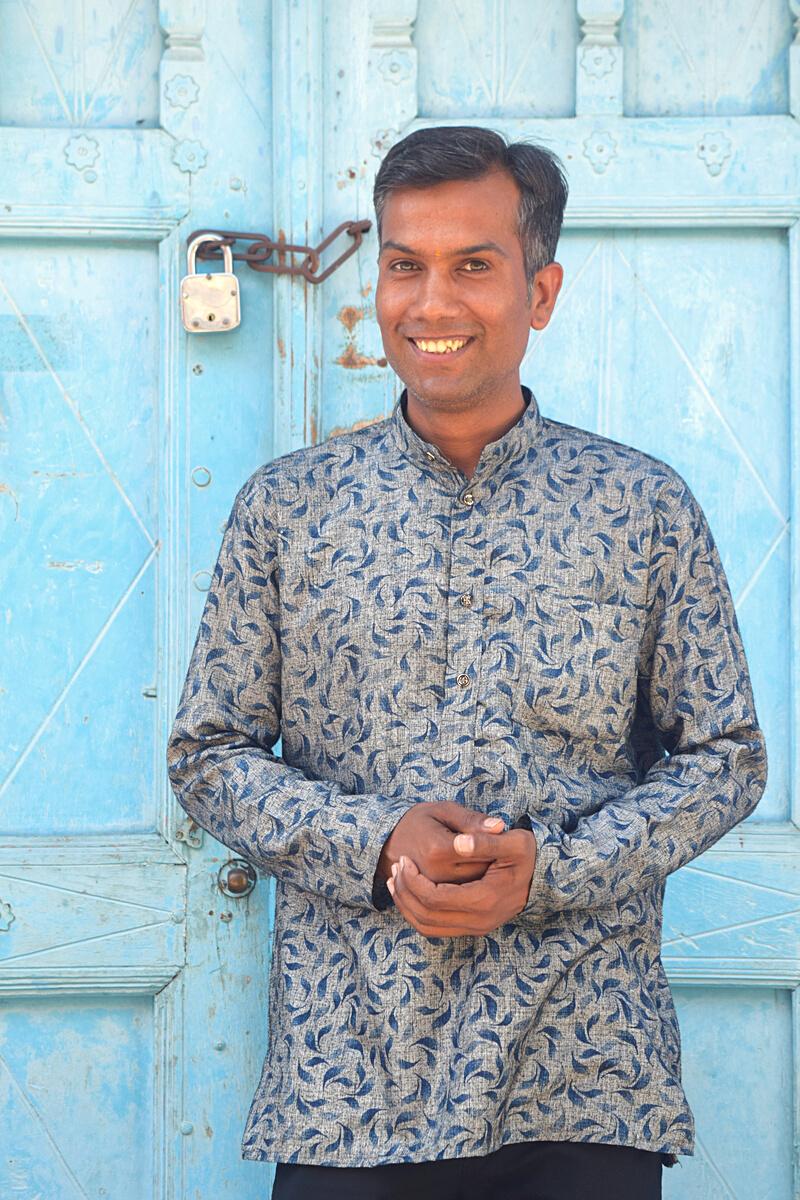
AGE : 32
GENDER: MALE
PHONE NO : +91-9660552330
VILLAGE : DELWARA, KHATIK MOHALLA
NAME: DINESH MEHTA
AGE : 28
GENDER: MALE
PHONE NO : +91-7300313203
VILLAGE : DELWARA, BUS STAND
NAME: KUNDAN SINGH MAJAWAT
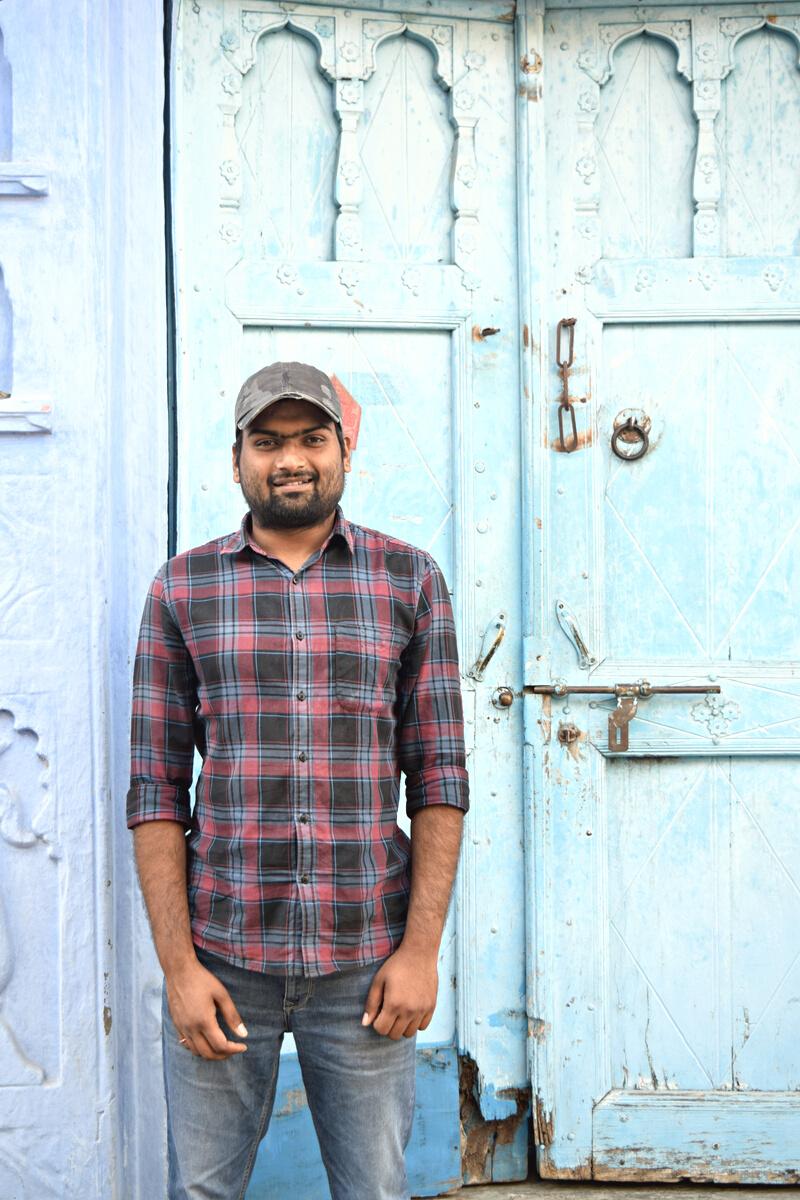
AGE : 33
GENDER: MALE
PHONE NO : +91-8503885536
VILLAGE : DELWARA, YADAV MOHALLA
NAME: SABIYA
AGE : 35
GENDER: FEMALE
PHONE NO : +91-9031110338
VILLAGE : DELWARA, MUSLIM BASTI

NAME: LAXMI JI
AGE : 27
GENDER: FEMALE
PHONE NO : +91-9835674567
VILLAGE : DELWARA, YADAV
MOHALLA
NAME: SHAMBHU KHATIK
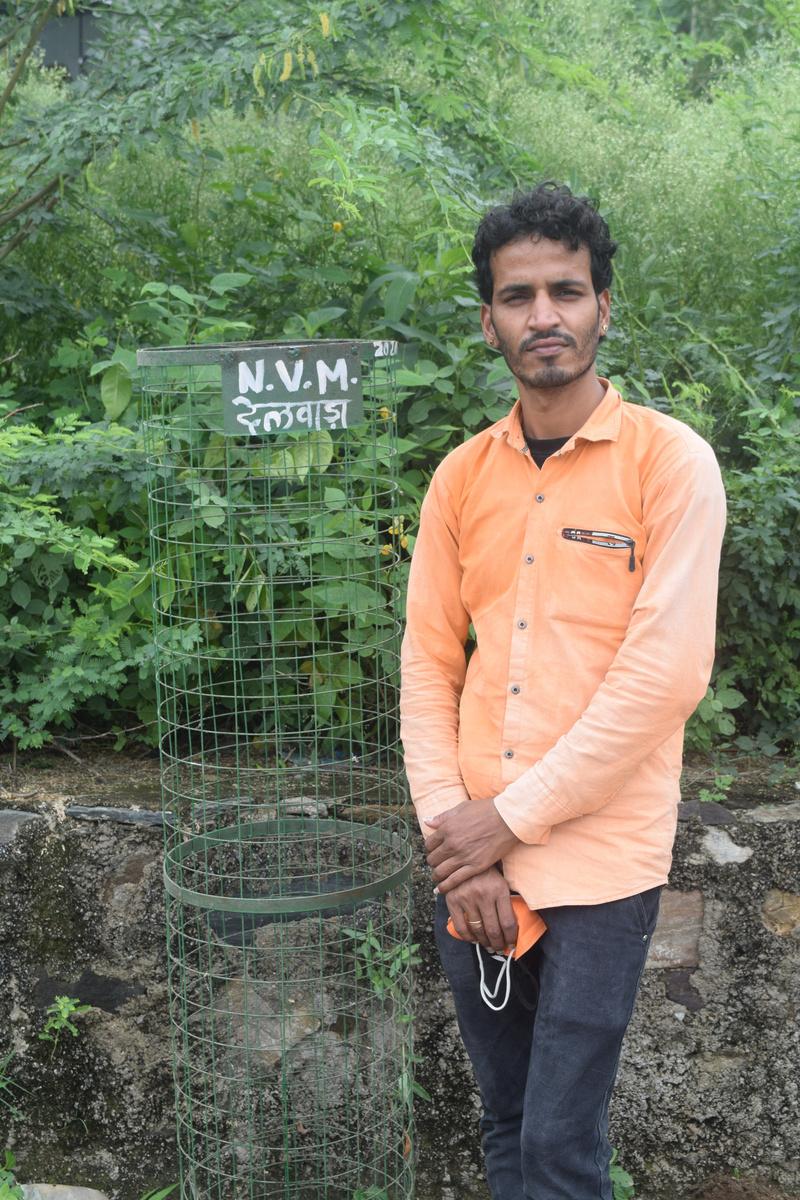
AGE : 28
GENDER: MALE
PHONE NO : +91-8278688083
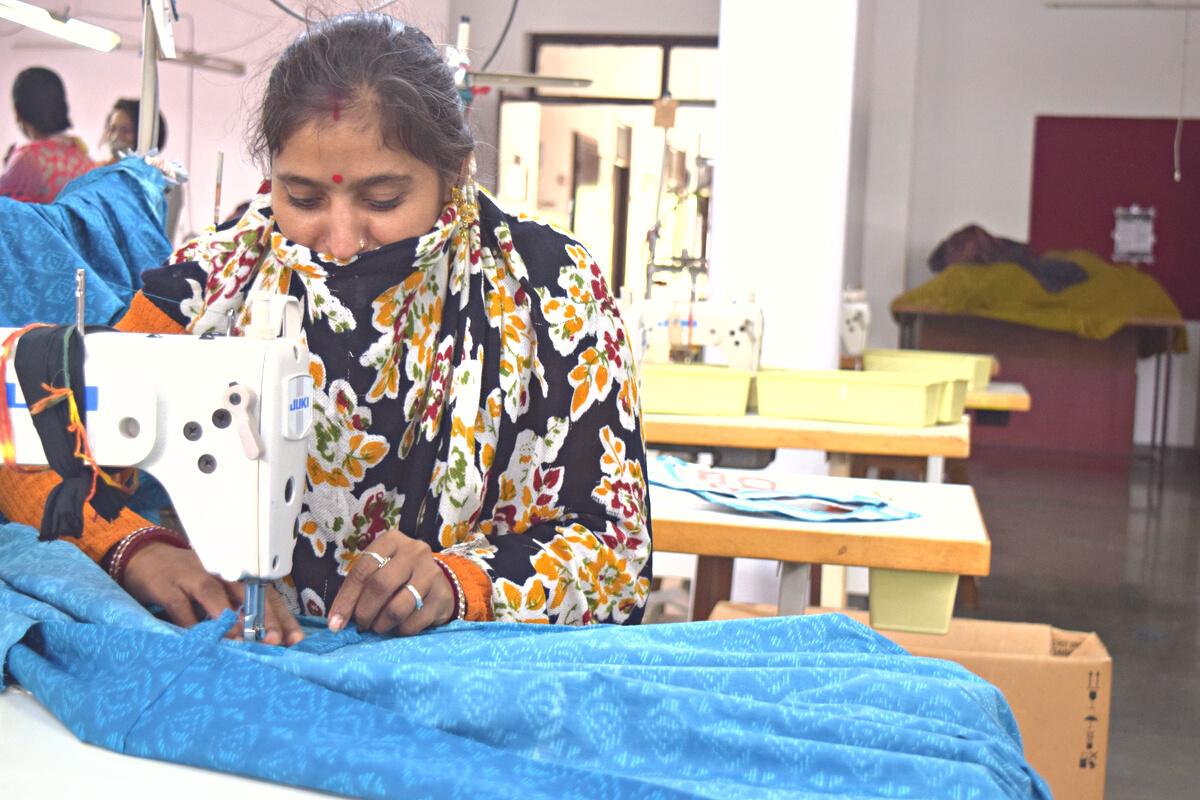
VILLAGE : DELWARA, YADAV
MOHALLA

Banno Yadav
Sabiya
Sophia
Sumitra
Kailash
Laxmi
Neema
Mamta
Mala
Pushpa
Puja
Bhawna
Deepshika
Yogita
Nainsikha
Sonal Rajput
Aarya
Gouri
Santosh
Vishnu Sisodia
Girija
Vidya Meghwal
Pooja Rani
Anushka Yadav
Aruna
Dikshita
Danish
Ayush
Harshit
Bharat
Vijay
Jayavardhan Yadav
Sandeep
Bhavik
Lakshya
Dinesh
Piyush


